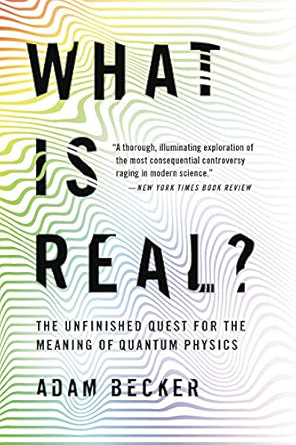More on this book
Community
Kindle Notes & Highlights
by
Adam Becker
Started reading
October 11, 2024
scientific theory influences the experiments that scientists choose to perform, the way new evidence is evaluated, and ultimately guides the search for new theories as well.
Bohm laid part of the blame for the Copenhagen interpretation at the feet of logical positivism,
Bohm pointed out, “the history of scientific research is full of examples in which it was very fruitful indeed to assume that certain objects or elements might be real, long before any procedures were known which would permit them to be observed directly.”
Tentative concepts are needed, even before empirical evidence is available, to guide the choice and design of experiments,
aid in their
interpret...
This highlight has been truncated due to consecutive passage length restrictions.
would argue in favor of the widest possible diffusion of knowledge of all the possibilities among physicists.
physicists ought to know of all the possibilities,
feel that while they do not know which of these are correct, they must be ready, if necessary, to abandon even what seemed most secure a...
This highlight has been truncated due to consecutive passage length restrictions.
Quantum physics perfectly correlated and predicted observations, and that’s all a scientific theory needed to do on a strictly positivist account of science.
This was the logic behind Bohr’s “rhetoric of inevitability,”
Copenhagen interpretation was not just the correct way of understanding quantum physics—they said it was the only way to do it,
Bohr’s camp, the search for another interpretation wasn’t just unnecessary, it was a waste of time.
Ultimately, Pauli thought that Bohm’s ideas were simply “artificial metaphysics.”
Bohr thought that Bohm’s theory was “very foolish,” and didn’t say much else.
Von Neumann, meanwhile, was less dismissive; he thought Bohm’s ideas were “consistent,” and even “very elegant,” but suspected that Bohm would have difficulties extending his theory to encompass the quantum phenomenon of spin—a suspicion that ultimately proved to be wrong.
Von Neumann’s suspicion was likely born of his own “im...
This highlight has been truncated due to consecutive passage length restrictions.
necessity of the Copenhagen int...
This highlight has been truncated due to consecutive passage length restrictions.
explanation of what had gone wrong in von Neumann’s proof, many physicists assumed the flaw was with Bohm’s theory instead—that it simply couldn’t be correct, because von Neumann had shown such theories were impossible.
few physicists who did come around to supporting Bohm’s view:
Louis de B...
This highlight has been truncated due to consecutive passage length restrictions.
Broglie’s institute in Paris became one of the few places in the world where dissent against the Copenhagen interpretation was the norm.
Lenin himself had condemned Mach;
“reactionary” and “solipsist.”
positivism that hung around the Copenhagen interpretation was enough to keep most Soviet physicists from defending Bohr’s ideas publicly under Stalin’s rule.
This led to the “age of banishment of complementarity” in the USSR,
several of de Broglie’s students
found both Marxism and pilot waves appealing.
Blokhintsev and Terletsky were critical of Bohr’s principle of complementarity and the other trappings of...
This highlight has been truncated due to consecutive passage length restrictions.
they did not support Bohm’s int...
This highlight has been truncated due to consecutive passage length restrictions.
instead pursuing their own alternatives to the qu...
This highlight has been truncated due to consecutive passage length restrictions.
USSR, there has been much criticism of quantum theory on ideological grounds, but it produced no results,
scared people away from these problems, rather than stimulate them.”
Khrushchev. This freed Russian physicists who had sat at Bohr’s feet to be more vocal in their support of the Copenhagen interpretation; one of them, Vladimir Fock, campaigned for Bohr’s ideas throughout the Soviet physics education system, referring to the pilot-wave interpretation as the “Bohm-Vigier illness.”
The USSR had already produced Lysenkoism, a bogus alternative to Darwinian evolution based on a “proper Marxist” understanding of biology.
One Marxist in particular had it in for Bohm: Léon Rosenfeld,
Pauli to nickname him “square root of Bohr × Trotsky.”
Rosenfeld spent much of his time participating in this nonexistent controversy, devoting remarkable effort to preventing the spread of Bohm’s ideas.
Rosenfeld’s views were largely shared by the physics community,
Half a dozen of the most eminent scientists have got their knife into him. Great honor for somebody so young.”
Rosenfeld thought Heisenberg was flirting with idealism—
Pauli and Born thought Rosenfeld was too politically motivated in his science.
many were troubled by an unavoidable fact of Bohm’s theory: it was nonlocal, allowing particles to influence each other instantaneously at long distances.
introduce a second particle that interacts in any way with the first, and suddenly they are linked—entangled—
exactly what Einstein had argued against in the EPR paper.
To them, the manifest action at a distance in Bohm’s theory was another strike against it when compared to Copenhagen.
question of whether Bohm’s ideas would actually lead to new research insights.
Relativistic quantum theory, known as quantum field theory (QFT),
active and productive area of research in the United States and Europe. QFT was originally pioneered by Dirac and was being led at the time by people like Feynman, Julian Schwinger, Sin-Itiro Tomonaga, and Freeman Dyson.
Dirac had used it to predict the existence...
This highlight has been truncated due to consecutive passage length restrictions.


